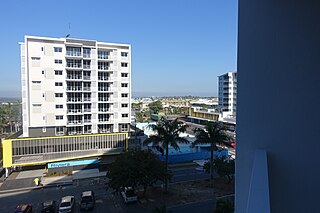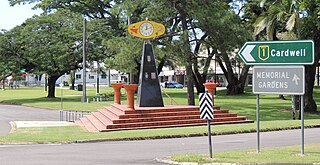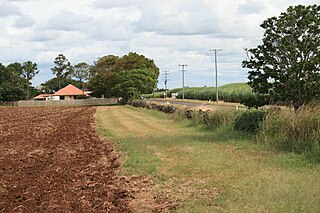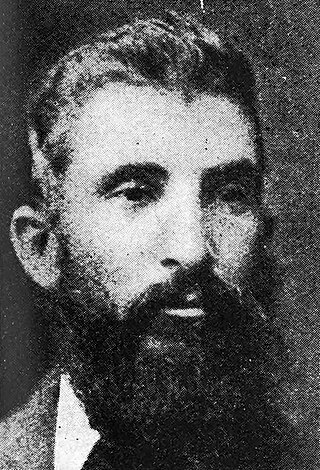
John Ewen Davidson (2 March 1841 in London – 2 September 1923 in Oxford) was a colonist sugar planter, slave owner, murderer, [1] and miller in Queensland.

John Ewen Davidson (2 March 1841 in London – 2 September 1923 in Oxford) was a colonist sugar planter, slave owner, murderer, [1] and miller in Queensland.
John Ewen Davidson was born as the son of a Scottish merchant. He was educated Harrow School and Oxford, where he graduated with a Bachelor of Arts in 1862. He was also a member of the Marylebone Cricket Club in London and played one first class cricket match in 1864. After a trip to the West Indies and British Guiana he came to Australia in 1865. There he met pioneer Queensland sugar planter Captain Claudius Whish and visited his farm at Caboolture, where he was shown, how to grow sugar in the climatic conditions of Queensland. [2]
A year later, he began as a sugar planter at Bellenden Plains on the Murray River north of Cardwell in Far North Queensland. According to his own diary entries, Davidson was involved in frequent mass shootings of Aboriginal people in this area as he tried to establish his sugar plantation. In January 1866, he accompanied sub-Inspector Reginald Uhr and his troopers of the Native Police who pursued and shot down "some blacks". In March, Davidson again participated in a raid on the local people by the Native Police and "no end of bags, fish baskets, spears were brought back" as plunder. Davidson was additionally aided by Inspector John Murray of the Native Police, who would arrive "to clear out the blacks". Davidson instructed his kanaka (slaves) to take guns into the canefields at Bellenden and to shoot any trespassers. [3]
After his plantation at Bellenden Plains was destroyed by a flood in late 1866, Davidson sold out of the area. Before his departure from the area, Davidson participated in a large punitive expedition against the indigenous people of Goold Island located just north of Hinchinbrook Island. After "dispersing" the "Goold Island niggers", this group "sailed back to Cardwell with a string of canoes". [1]
Thus, he relocated to Mackay in 1867 and set-up the cotton and sugar plantation Alexandra together with Thomas Henry Fitzgerald. He investigated new varieties of sugar cane and methods of production and visited many other areas in the world over his career. As Davidson participated in violent raids on a number of Aboriginal camps, he was able to collect Aboriginal artefacts for the British Museum. In most cases, however, Davidson and others would burn the weapons and instruments that were left behind after these attacks. He recorded a species of plum tree and was the first Britisher to identify a comet in Queensland with his own telescope. [2] [4] He also donated aboriginal artefacts to the Dresden Museum of Ethnology in 1881: A shield (No 33073) found at the Mulgrave River shows an inscription on the handle ‘Australia from Baessler’, which is an indication that Davidson had teamed-up with the German anthropologist and photographer Arthur Baessler (1857–1907) when he travelled in Australia in 1891–1893. [5]
From approximately 1881, he part-owned W. Sloane & Co. in Melbourne, which invested heavily in the Mackay sugar industry. It changed its name to Melbourne Mackay Sugar Company in 1882. Subsequently, Davidson managed six mills and estates using the most modern and expensive equipment. In 1884, Davidson travelled to England to try to persuade the Colonial Office to allow importations of Indian labourers, after the kanaka trade had ceased. [6] After the crisis of the Queensland sugar industry in 1888, Davidson testified to the Royal Commission into the industry that four of the six of his company's estates were idle. He sought protection to protect the fledgling Queensland industry from European bounty-fed beet sugar. Due to the advent of the Federation and introduction of governmentally supported Central Mills, the cane industry declined and the business of the large sugar estates slowed-down significantly. [2]
On 1 August 1875, Davidson married Amy Constance Ashdown, from Sydney. They had two sons and four daughters together. [6]
Around 1900, he returned with his family for his retirement to England, and died there at his Oxford home on 2 September 1923.

Source required.

Ingham is a rural town and locality in the Shire of Hinchinbrook, Queensland, Australia. It is named after William Bairstow Ingham and is the administrative centre for the Shire of Hinchinbrook.

North Queensland or the Northern Region is the northern part of the Australian state of Queensland that lies just south of Far North Queensland. Queensland is a massive state, larger than many countries, and its tropical northern part has been historically remote and undeveloped, resulting in a distinctive regional character and identity.

Harold Heneage Finch-Hatton was a British politician and Australian federationist.
Sugar cane grew wild in Fiji and was used as thatch by the Fijians for their houses (bures). The first attempt to make sugar in Fiji was on Wakaya Island in 1862 but this was a financial failure. With the cotton boom of the 1860s there was little incentive to plant a crop that required high capital outlay but after a slump in cotton prices in 1870, the planters turned to sugar. In an effort to promote the production of sugar in Fiji, the Cakobau Government, in December 1871, offered a 500-pound reward for the first and best crop of twenty of sugar from canes planted before January 1873.

Claudius Buchanan Whish was a prominent sugar-planter, civil servant and politician in Queensland, Australia. He was a Member of the Queensland Legislative Council.

The Mackay Railway was a 68 kilometres (42 mi) line situated in the Pioneer River valley in North Queensland, Australia. It opened in a series of sections between 1885 and 1911. It had three short branches, parts of which were initially built by the local government. It closed in sections between 1959 and circa 2007.

Morayfield Plantation is a heritage-listed ruins of a sugarcane plantation at 34 Nolan Drive, Morayfield, City of Moreton Bay, Queensland, Australia. It was built in circa 1860s. It was added to the Queensland Heritage Register on 13 May 2011.

Oaklands Sugar Mill is a heritage-listed remains of a former sugar cane mill at 68 Captain Whish Avenue, Morayfield, City of Moreton Bay, Queensland, Australia. It was built in 1865. It is also known as Whish's Sugar Mill Remnants. It was added to the Queensland Heritage Register on 18 September 2009.

Sunnyside Sugar Plantation is the heritage-listed remains of a former sugar plantation at 94 Windermere Road, Windermere, Bundaberg Region, Queensland, Australia. It was built in c. 1880s by South Sea Islander labour. It is also known as Dry-rubble Boundary Wall. It was added to the Queensland Heritage Register on 13 May 1996.

Carmila Cane Lift is a heritage-listed piece of agricultural equipment at 49 Hindles Road, Carmila, Isaac Region, Queensland, Australia. It was built between the 1920s and the 1960s. It was added to the Queensland Heritage Register on 5 February 2010.

Finch Hatton railway station is a heritage-listed former railway station at Mackay-Eungella Road, Finch Hatton, Mackay Region, Queensland, Australia. It was built in 1904. It is also known as Hatton railway station and Pelion railway station. It was added to the Queensland Heritage Register on 6 December 2004.

Mount Martin Cane Lift is a heritage-listed piece of agricultural equipment at Mirani Mount Ossa Road, Mount Martin, Mackay Region, Queensland, Australia. It was built before 1939. It was added to the Queensland Heritage Register on 5 February 2010.

The Leap Cane Lift is a heritage-listed piece of agricultural equipment at Bruce Highway, The Leap, Mackay Region, Queensland, Australia. It was built before the 1960s. It was added to the Queensland Heritage Register on 5 February 2010.

Mirani railway station is a heritage-listed former railway station on the former Pioneer Valley railway line at Victoria Street, Mirani, Mackay Region, Queensland, Australia. It was built from 1885 to 1913. It is also known as Hamilton railway station. It was added to the Queensland Heritage Register on 7 July 2005.

Habana Tramline Causeway and Wharf Site is a heritage-listed causeway between Habana Wharf Road and Constant Creek, Habana, Mackay Region, Queensland, Australia. It is also known as Habana Wharf Road. It was added to the Queensland Heritage Register on 14 May 2010.

Richmond Mill Ruins is a heritage-listed sugar cane mill at Habana Road, Richmond, Mackay, Mackay Region, Queensland, Australia. It was built in 1881. It is also known as Richmond Mill. It was added to the Queensland Heritage Register on 4 June 1996.

Selwyn House is a heritage-listed Anglican mission at 12 Cowleys Road, Racecourse, Mackay, Mackay Region, Queensland, Australia. It was built from 1890s to 1918. It was added to the Queensland Heritage Register on 23 February 2001.

Pacific Islander Hospital and Cemetery site is a heritage-listed archaeological site of a former hospital and private cemetery at the corner of Bluebell Road East and Gernich Road, Tinana, Fraser Coast Region, Queensland, Australia. It was built from 1883 to 1888. It is also known as Pacific Islander Hospital and Cemetery site, South Sea Islander Hospital and Cemetery site, and Pacific Islander Hospital, Maryborough. It was added to the Queensland Heritage Register on 27 October 2017.

Robert Arthur Johnstone was an officer in the Native Police paramilitary force which operated in the British colony of Queensland. He was stationed at various locations in central and northern Queensland between 1867 and 1880 conducting regular punitive expeditions against clans of Indigenous Australians who resisted colonisation. He also participated in several surveying expeditions in Far North Queensland, including those under the leadership of George Elphinstone Dalrymple.
{{cite journal}}: Cite journal requires |journal= (help)